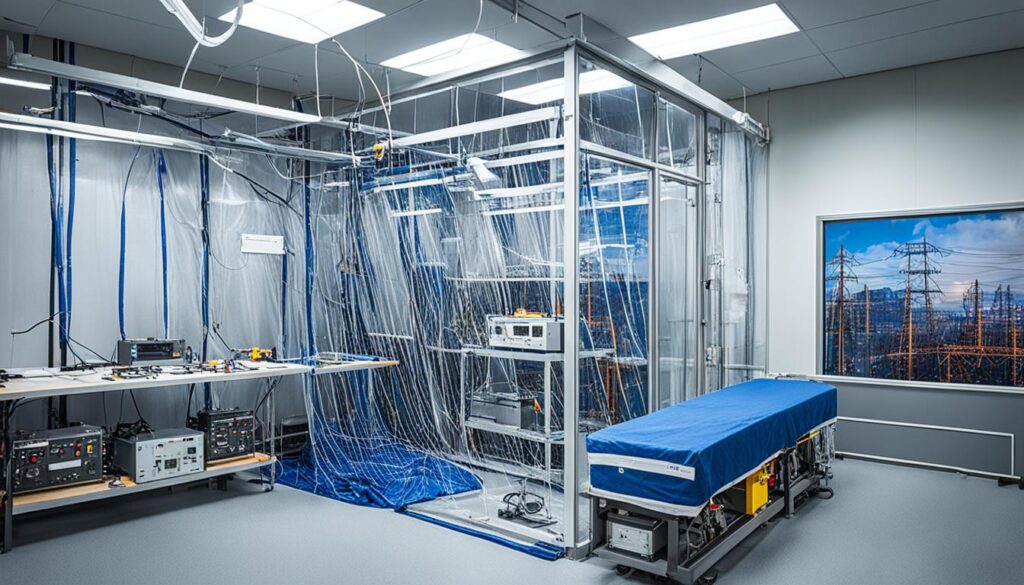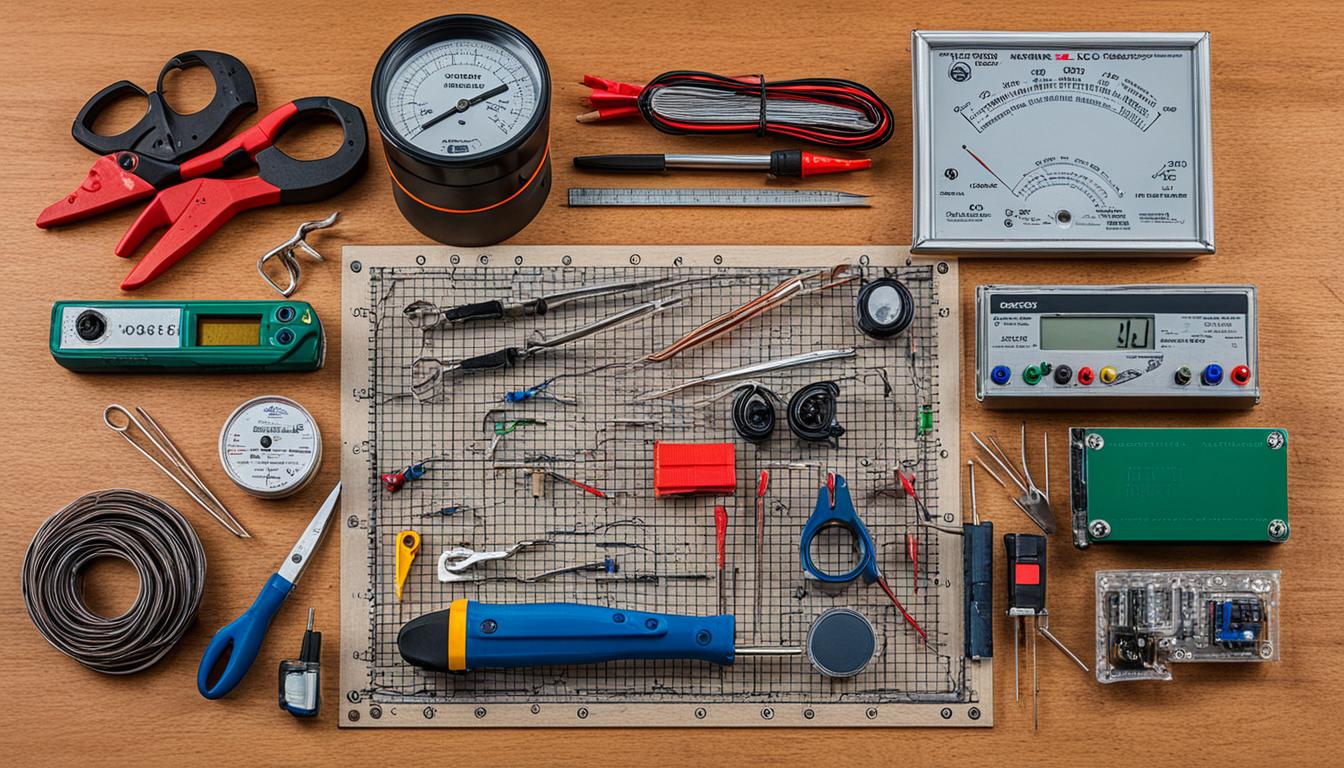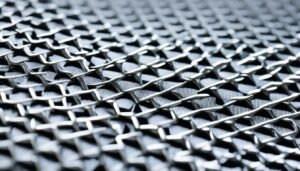Disclosure: This Post Contains Affiliate Links; We earn a commission on purchases.
In our modern world, we are surrounded by electromagnetic fields (EMFs) emitted by cell phone masts, WiFi networks, and other sources of radiation. Protecting ourselves from these EMFs is becoming increasingly important. That’s where shielding materials come in.
When it comes to DIY projects, choosing the right shielding materials is crucial. These materials are designed to reflect and block the majority of wireless radiation, providing a safer environment for you and your loved ones.
Key Takeaways:
- Shielding materials are essential for protecting against electromagnetic fields.
- Common shielding materials include reflective paints, window films, fabrics, canopies, curtains, and meshes.
- Measuring radiation levels in your space using a high frequency or low frequency radiation meter is essential to determine the need for shielding.
- Blocking wireless radiation can be achieved through the use of window films, curtains, electromagnetic shielding paint, stainless steel mesh, electromagnetic shielding fabric, and shielded bed canopies.
- When shielding from high voltage lines and electrical equipment, magnetic shielding materials and electric field shielding methods are essential.
How to Measure Radiation Levels in Your Space
Radiation levels in a space can be measured using different types of radiation meters. These meters allow you to determine the levels of wireless radiation and other forms of radiation in your environment, providing crucial information for assessing the need for EMF shielding. By measuring radiation levels, you can gain insights into the potential risks and take appropriate steps to protect yourself and your loved ones.
Choosing the Right Radiation Meter
Depending on the type of radiation you want to measure, there are different meters available:
- High Frequency Radiation Meter: This meter is specifically designed to measure wireless radiation, such as that emitted by cell phones, Wi-Fi routers, and other wireless devices. It helps you understand the level of exposure to electromagnetic fields generated by these devices.
- Low Frequency Radiation Meter: This meter is used to measure electric and magnetic fields produced by power lines, electrical appliances, and other sources. It provides insights into the non-wireless electromagnetic fields present in your space.
- Combination Meter: For convenience and versatility, you can opt for a combination meter that can measure both high frequency and low frequency radiation. This type of meter offers a comprehensive assessment of the electromagnetic fields in your environment.
Why Measure Radiation Levels
Measuring radiation levels is essential for several reasons:
- Assessing Potential Risks: By understanding the radiation levels in your space, you can evaluate the potential risks associated with prolonged exposure to electromagnetic fields. This knowledge empowers you to make informed decisions about EMF shielding and necessary lifestyle changes.
- Identifying Hotspots: Radiation meters help you identify areas in your space with the highest radiation levels. This information enables you to pinpoint specific sources of radiation and implement targeted shielding solutions.
- Evaluating Shielding Effectiveness: After implementing EMF shielding measures, measuring radiation levels allows you to assess the effectiveness of your shielding strategies. It provides tangible evidence of the reduction in radiation levels and validates the efficacy of your efforts.
Take Control of Your Environment
By measuring radiation levels, you take an active role in protecting yourself and creating a healthier living environment. It is recommended to periodically measure radiation levels, especially when setting up new devices or implementing shielding projects, to ensure ongoing safety and peace of mind.
Remember, knowledge is power, and by measuring radiation levels, you gain valuable insights into your exposure and can make informed decisions to reduce potential risks.
How to Shield a Space from Wireless Radiation
Wireless radiation can easily enter buildings through windows, unless the glass has a metal coating. To block wireless radiation, you can use window films or curtains with a special weave of copper and silver. These materials help reflect and reduce the penetration of wireless radiation into your space.
An alternative option is to apply electromagnetic shielding paint to walls and even the floor. This paint contains conductive elements that can further minimize radiation levels in the space.
If you are in the process of constructing a new space, you can consider placing special stainless steel meshes on walls or floors that have not yet been plastered or laid. These meshes act as a barrier, preventing wireless radiation from entering the space.
For areas where the radiation source is below furniture, such as a sofa or bed, electromagnetic shielding fabric can be placed underneath. This fabric serves as an extra layer of protection against wireless radiation.
If you are particularly concerned about reducing radiation exposure during sleep, shielded bed canopies provide practical solutions. These canopies create a safe and protected space for rest, allowing you to sleep without worrying about wireless radiation.
The effectiveness of these shielding methods depends on the reflection provided by each material and the coverage of surfaces. Using the main shielding materials that provide shielding rates of 20-40dB can significantly reduce radiation values by more than 90%. To achieve even higher shielding rates of over 99%, special wallpapers, canopies, curtains, or a combination of materials can be used.

Why is Shielding a Space from Wireless Radiation Important?
The increasing use of wireless devices and the proliferation of wireless networks have raised concerns about the potential health effects of prolonged exposure to wireless radiation. Shielding a space from wireless radiation can help mitigate these concerns and create a safer and more comfortable living or working environment.
How to Shield a Space from High Voltage Lines and Electrical Equipment
High voltage lines, transformers, and electrical panels can generate magnetic fields and electric fields that may have potential health implications. Shielding a space from these electromagnetic fields (EMFs) is crucial for maintaining a safe and healthy environment. In this section, we will explore effective methods to shield a space from high voltage lines and electrical equipment.
Magnetic Shielding Materials
Magnetic shielding materials play an essential role in reducing magnetic field values. These materials possess high permeability, which allows them to redirect the flow of magnetic field lines, minimizing their impact on the surrounding space. It is important to note that common metals like copper, lead, or aluminum are not suitable for magnetic field shielding due to their low permeability.
Shielding the Source
Shielding the source of magnetic fields, such as transformers or electrical panels, can be a relatively easier solution compared to shielding an entire room. By focusing on the specific areas where the magnetic fields originate, it is possible to minimize their reach and potential effect on the surrounding environment. Consulting with experts in the field can help determine the most suitable approach for shielding high voltage lines and electrical equipment.
Electric Fields Shielding Methods
In addition to magnetic fields, high voltage lines and electrical equipment can also generate electric fields. Shielding these electric fields requires a different set of methods. Some effective practices include:
- Creating distance from the walls
- Moving power cords away from the body
- Grounding appliances
- De-energizing circuits during bedtime
Dirty Electricity Shielding Methods
Dirty electricity refers to irregularities in the electrical current, which can contribute to the electromagnetic pollution in a space. To mitigate the effects of dirty electricity, it is important to identify and eliminate the sources within the home. This may involve using specialized filters or modifying electrical systems to ensure a cleaner flow of electricity.
It is worth noting that shielding from high voltage lines and electrical equipment often requires specific expertise and techniques. Complex approaches like active magnetic shielding may be necessary to achieve optimal results. However, it is important to acknowledge that power lines are often challenging to shield completely, and their impact on magnetic fields inside a home is difficult to mitigate.

Shielding a space from high voltage lines and electrical equipment is an important aspect of EMF protection. By implementing the appropriate shielding materials and techniques, it is possible to create a safer living or working environment.
What is a Faraday Cage and How to Construct It
A Faraday cage is a conductive shell that covers all surfaces of an area and shields most types of artificial electromagnetic radiation. It creates a metal box-like environment where radio waves bounce off the metal and are deflected back, reducing exposure to external electromagnetic fields.
Constructing a Faraday Cage
Constructing a Faraday cage involves covering every surface of a room with grounded shielding materials, such as conductive paint or mesh. This ensures that the cage is effective in blocking electromagnetic radiation. Proper grounding techniques must also be employed to ensure that the cage functions optimally.
Conductive shielding bed canopies can also act as Faraday cages in the bed area, providing protection during sleep.
Uses of Faraday Cages
Faraday cages serve various purposes, including:
- Protecting sensitive electronic equipment: Faraday cages are commonly used in laboratories, manufacturing facilities, and data centers to shield valuable equipment from external electromagnetic interference.
- Preventing wireless data theft: Faraday cages can be used to block wireless signals, preventing unauthorized access to sensitive data. They are particularly useful in settings where data security is critical.
- Reducing exposure to electromagnetic fields: Faraday cages can provide a safe space with reduced electromagnetic field levels, offering protection to individuals who are sensitive to or wish to limit their exposure to electromagnetic radiation.
Benefits of Faraday Cages
The construction of a Faraday cage using appropriate shielding materials provides several benefits, including:
A Faraday cage acts as a physical barrier, offering an extra layer of protection against electromagnetic radiation. It helps create a safer environment, reducing the risk of potential health effects associated with prolonged exposure to electromagnetic fields.
Image:
When constructing a Faraday cage, it is crucial to carefully consider the materials used and ensure proper installation to optimize its effectiveness in shielding electromagnetic radiation.
Conclusion
Protecting oneself from electromagnetic fields (EMFs) is becoming increasingly important in our modern, high-tech world. With various devices emitting EMFs and ongoing research on their potential health effects, it is essential to take steps to reduce exposure.
DIY EMF shielding projects provide a cost-effective way to minimize EMF exposure. By utilizing a range of shielding materials such as paints, fabrics, films, and canopies, individuals can create a safer environment within their homes and workplaces.
However, it is crucial to approach DIY shielding projects with an understanding of their limitations and the scientific nuances of EMF exposure. While these projects can significantly reduce EMF exposure, complete elimination of EMFs is not possible. Lifestyle changes like reducing the use of EMF-emitting devices and maintaining distance from them also play a vital role in minimizing exposure.
Choosing the right EMF shielding materials and implementing them correctly can make a substantial difference in creating a safer living and working environment. By applying the precautionary principle and staying informed about the latest research, individuals can take proactive steps towards protecting themselves from the potential risks associated with EMFs.
Source Links
- https://www.home-biology.com/electromagnetic-shielding-guide/how-to-shield-your-house-from-eleectromagnetic-fields
- https://www.shieldyourbody.com/whole-home-emf-shielding/
- https://eastwindhealing.com/diy-emf-protection/

Subscribe to Our Newsletter










